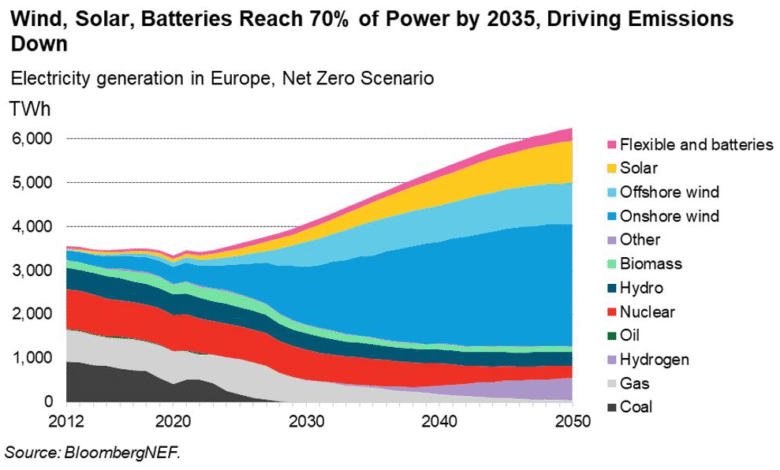EU Energy Investment: Trump’s $750 Billion Promise Explained

EU energy investment is at the forefront of international economic discourse, particularly in the context of ambitious pledges and negotiations between the United States and the European Union. President Trump has touted the EU’s $750 billion energy promise, believing it will catalyze renewed prosperity for both economies. However, experts express doubts about the feasibility of such investments, noting the complexities involved in energy purchases and international trade dynamics. With a focus on increasing U.S. energy exports, including liquefied natural gas (LNG), the EU aims to diversify its energy sources and reduce reliance on Russia. As these negotiations unfold, the implications of the EU’s energy strategy on transatlantic relations and global markets remain a critical point of analysis.
Discussing the strategic financial commitments from the European Union regarding energy, we encounter the significant realm of transatlantic investments aimed at reshaping energy security. This $750 billion commitment by the EU not only seeks to bolster economic ties with the U.S. but also to transition towards more sustainable energy solutions. The potential for heightened U.S. energy exports, especially in liquefied natural gas, indicates a shift in global supply chains and investment flows. As the EU prioritizes its energy diversification efforts, understanding the long-term implications of these development deals, and their impact on trade relations becomes paramount. This intricate interplay of energy investment strategies marks a transformative phase in global energy markets.
The Impact of Trump’s Trade Deals on EU Energy Investments
Trump’s push for a strong trade relationship with the EU is significantly tied to the $750 billion energy investment promise. This ambitious pledge raises questions about its feasibility and the actual impact it will have on both economies. While Trump projects prosperity resulting from increased energy exports, analysts caution that without solid commitments from EU nations, this promise could remain just that—an ideal rather than reality. The intricacies of international trade, especially under the current tariff regime, mean that the expected inflow from U.S. energy sales might not materialize as anticipated.
Furthermore, the notion that the EU will seamlessly increase its energy purchases hinges on various factors, including market stability and geopolitical dynamics, particularly given the ongoing energy crisis fueled by dependence on Russian supplies. Emre Peker underscores that for Trump’s trade policies to yield meaningful results, there needs to be demonstrable EU interest in investing in U.S. energy infrastructure and technology. As it stands, the enthusiasm over potential rewards must be tempered with realistic assessments of trade flows and energy demands.
Evaluating the Reality of the EU’s $750 Billion Energy Promise
The EU’s commitment to purchasing $750 billion worth of U.S. energy products within a set timeframe is ambitious and potentially unrealistic. Analysts like Ana Maria Jaller-Makarewicz from IEEFA express skepticism over whether EU countries can sustain such a high level of investment and purchase amidst fluctuating market conditions. Even a surge in liquefied natural gas (LNG) imports from the U.S. might not be sufficient to meet the envisioned targets, raising doubts about the overall tactical approach towards this energy investment.
Moreover, many of the agreed-upon figures are not merely about numbers but rather reflect the political landscape surrounding energy diplomacy between the U.S. and the EU. The actual volume of U.S. energy exports to the EU may need to grow exponentially from current levels to achieve the $750 billion commitment—estimated by industry experts to be far from realistic based on recent purchase patterns. The goals appear to be more symbolic than operational at this stage, revealing significant discrepancies between political rhetoric and economic realities.
Exploring the Geopolitical Implications of Energy Trade Deals Between the U.S. and the EU
The geopolitical consequences of enhancing energy trade relations between the U.S. and the EU cannot be overstated. Trump’s energy pledge has major ramifications, especially as the EU aims to cut dependency on Russian energy sources. By potentially increasing their purchases of U.S. liquefied natural gas and other energy exports, EU nations could simultaneously bolster their energy independence and support U.S. economic interests. Yet, this relationship is complex, requiring careful navigation of international trade agreements and domestic market regulations.
Simone Tagliapietra, a notable economist from the Bruegel think tank, points out that while the U.S. seeks to solidify its position within the global energy market, the intricate realities of supply chain logistics and current energy demands suggest that meeting the ambitious EU investment goals may be more challenging than proposed. As a balancing act between energy security and market consumption unfolds, the future of EU energy investments in U.S. resources will largely compete with the pressing need for a stable supply and pricing formats.
Assessing Market Dynamics Affecting EU Energy Purchases from the U.S.
The dynamics of energy trading between the U.S. and the EU are significantly influenced by market factors, with supply limitations and competition from other sources playing key roles in shaping the investments. Despite efforts to increase energy exports, industry trends hint that the existing capacity to supply the predicted demands is limited. The aforementioned challenges indicate that EU energy purchases, which include natural gas and oil from the U.S., will primarily be dictated by real market needs rather than the optimistic targets set during political negotiations.
Furthermore, the complexities of the liquefied natural gas (LNG) market mean that while the U.S. can ramp up production, logistical barriers such as port capacity, transportation, and existing contracts with other suppliers will impact the volume of exports to the EU. Analysts predict that unless these barriers are mitigated, the ambitious targets may render themselves unattainable. To make the proposed investment credible, it is crucial that both parties exhibit flexibility and a willingness to adapt to evolving market conditions.
The Role of Tariffs in Shaping U.S.-EU Energy Trade Relationships
Tariffs play a pivotal role in influencing the energy trade relationship between the U.S. and the EU. Trump’s administration has implemented a tariff ceiling on EU goods to encourage the bloc to increase its energy purchases from the U.S. At the same time, the reduced tariff rate from the previously threatened 30% to 15% provides a breathing space for EU nations to engage more freely with American energy suppliers. This strategic move aims to foster a more favorable trading environment where European countries might find investments in U.S. energy less economically burdensome.
However, it is essential to analyze how these tariffs impact the overall competitiveness of U.S. energy exports in global markets. If the EU is to fulfill its commitments regarding energy purchases without succumbing to excessive costs, U.S. suppliers need to remain competitive against other energy sources. This ongoing tariff strategy will require careful adjustments based on market responses to avoid undermining the anticipated economic benefits.
Future Perspectives on Transatlantic Energy Collaboration
Looking ahead, the potential for transatlantic energy collaboration rests heavily on both sides’ commitment to navigate through existing challenges. The U.S.’s ability to cater to European energy demands, especially in light of the EU’s pivot away from Russian energy, is an opportunity for solidifying long-term relationships. As the U.S. seeks to expand its footprint in energy markets globally, aligning with the EU’s objectives could ease procurement complexities and facilitate smoother processes for energy investments.
Still, the sustainability of this energy partnership hinges on practical engagement from both parties. Real established collaboration will arise from acknowledging current market constraints and recognizing the necessity for viable energy logistics. Both sides need to prioritize flexibility and responsiveness to market dynamics, ensuring that the ambitious energy targets due not only serve political rhetoric but also fulfill substantive economic objectives.
The Importance of Realism in Energy Investment Agreements
In the realm of international energy investment agreements, setting realistic expectations is crucial. The optimistic figures proposed by the Trump administration regarding the EU’s $750 billion energy investment promise may not accurately reflect the market’s capabilities and behaviors. As energy markets are subject to quick changes due to geopolitical tensions and economic fluctuations, both parties must prioritize achievable targets to maintain a credible partnership.
Adopting a more pragmatic approach could involve reassessing the actual demand for energy products within Europe and corresponding supply capabilities within the U.S. By focusing on practical solutions rather than merely aspirational promises, the EU and the U.S. can build a more robust relationship that benefits both economies while ensuring energy security and stability.
Challenges of Transitioning to U.S.-Supplied Energy Sources
Transitioning to U.S.-supplied energy sources poses several challenges for the EU. As the bloc plans to reduce its dependency on Russian energy, importing LNG and other fossil fuels from the U.S. becomes critical. However, the current capacities of U.S. energy production and supply chain logistics may not meet the rapid pace at which the EU desires this transition. Structural constraints in both regions can lead to discrepancies in what is promised versus what can be delivered.
Moreover, the complexity of energy trading agreements, combined with the fluctuating prices of energy commodities, necessitates clear and strategic planning. To achieve the investment goals stated by Trump, the EU must not only consider purchase commitments but also the long-term sustainability of energy imports from the U.S. Balancing environmental objectives and energy needs during this transition phase presents an additional layer of challenge.
Monitoring the EU’s Energy Purchases: A Key Indicator of Success
Monitoring the actual energy purchases made by the EU is essential in determining the success of the proposed $750 billion energy investment agreement. Incremental purchases of LNG, oil, and other energy resources reflect the seriousness of the EU’s commitments and the level of compliance with the trade agreement. Tracking these purchases will be a significant indicator of whether the trade relationship will evolve positively or face challenges stemming from unmet expectations.
Furthermore, establishing transparent communication regarding energy commitments and investments can foster trust between the U.S. and the EU. As energy needs evolve, being responsive to changes and actively communicating about challenges in fulfilling these energy goals can help manage expectations and avoid potential disputes. By creating a collaborative environment, both parties can share insights, anticipate market trends, and work toward mutually beneficial outcomes.
Frequently Asked Questions
What is the significance of the EU’s $750 billion energy investment promise?
The EU’s $750 billion energy investment promise is critical as it aims to strengthen energy relations with the U.S. and reduce dependence on Russian energy. This commitment involves substantial purchases of U.S. liquefied natural gas (LNG), oil, and nuclear energy products, indicating a shift in EU energy sourcing strategies.
How does Trump’s EU trade deal relate to U.S. energy exports?
Trump’s EU trade deal emphasizes significant U.S. energy exports, particularly targeting the EU’s commitment to purchasing $750 billion worth of U.S. energy over three years. This deal intends to boost American energy sectors by increasing export volumes, thus restoring perceived wealth to the U.S. economy.
What are potential challenges to fulfilling the $750 billion energy promise by the EU?
Challenges to fulfilling the $750 billion energy promise include market dynamics, supply limitations, and current demand levels. Experts like Emre Peker caution that achieving the ambitious energy targets set by the EU may be unrealistic given these constraints.
How might the EU’s energy investment impact U.S.-EU trade relations?
The EU’s energy investment is expected to positively impact U.S.-EU trade relations if it results in increased EU energy purchases from the U.S., helping balance transatlantic trade and reducing tariffs, as demonstrated by Trump’s agreements.
What role does liquefied natural gas play in the EU’s energy strategy?
Liquefied natural gas (LNG) plays a pivotal role in the EU’s energy strategy as it seeks to replace Russian energy supplies. The increase in EU LNG imports from the U.S., which have nearly tripled recently, reflects a clear shift towards diversifying energy sources.
How does the EU’s planned energy purchases fit into Trump’s broader economic goals?
Trump views the EU’s planned energy purchases as integral to his broader economic goals of restoring wealth to the U.S. economy. The $750 billion investment is seen as a means to enhance U.S. energy exports and reduce trade deficits.
What are the implications if the EU fails to meet its energy investment commitments?
If the EU fails to meet its energy investment commitments, it may face higher tariffs, as Trump indicated a potential increase to 35%. This could strain U.S.-EU relations and hinder the overall trade deal meant to benefit both parties.
Why are energy analysts skeptical about the EU’s $750 billion energy promise?
Energy analysts are skeptical of the EU’s $750 billion energy promise due to the difficulty in meeting such targets within the specified timeframe. Issues such as market demand, supply constraints, and geopolitical factors complicate the fulfillment of these commitments.
What is the expected outcome of the EU’s energy commitment by 2029?
By 2029, the EU is expected to make at least $600 billion in investments across various sectors, with significant focus on U.S. energy purchases. However, achieving the proposed $750 billion promise remains uncertain and speculative.
| Key Point | Description |
|---|---|
| Trump’s Enthusiasm | Trump claims EU’s $750 billion energy pledge will restore wealth, though analysts doubt its viability. |
| Trade Deal Dependence | Analysts note EU must show increasing energy purchases to sustain U.S.-EU trade relations. |
| Tariff Structure | U.S. lowered tariff ceiling to 15% for EU goods, contingent on the EU’s investment commitments. |
| Investment Commitments | EU plans to invest $600 billion in various sectors by 2029 and $750 billion for U.S. energy purchases. |
| Skepticism on Viability | Experts believe commitments are unrealistic, with potential to achieve only $170 billion annually. |
| Market Dynamics | Current market limits and supply constraints raise questions about meeting ambitious energy targets. |
Summary
EU energy investment plays a crucial role in shaping transatlantic relations, especially in light of Trump’s claims about the EU’s $750 billion energy promise. Despite the enthusiasm, analysts express concerns over the feasibility and realism of these commitments. With ongoing discussions about trade tariffs and energy purchases, the dynamics of EU energy investment are pivotal in determining the future of economic partnerships and energy security strategies.




